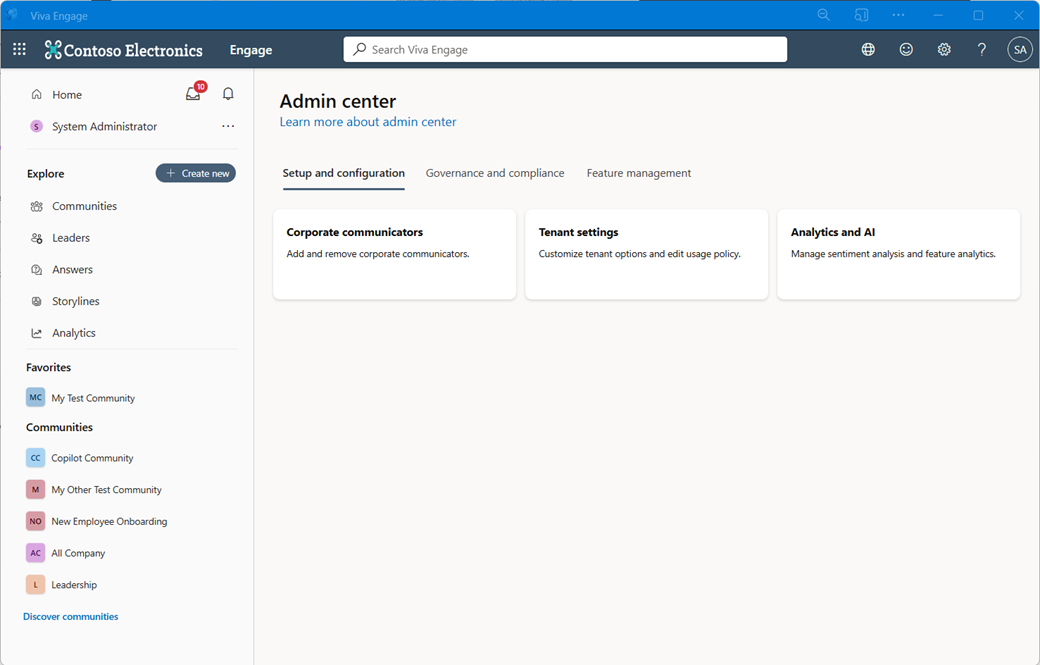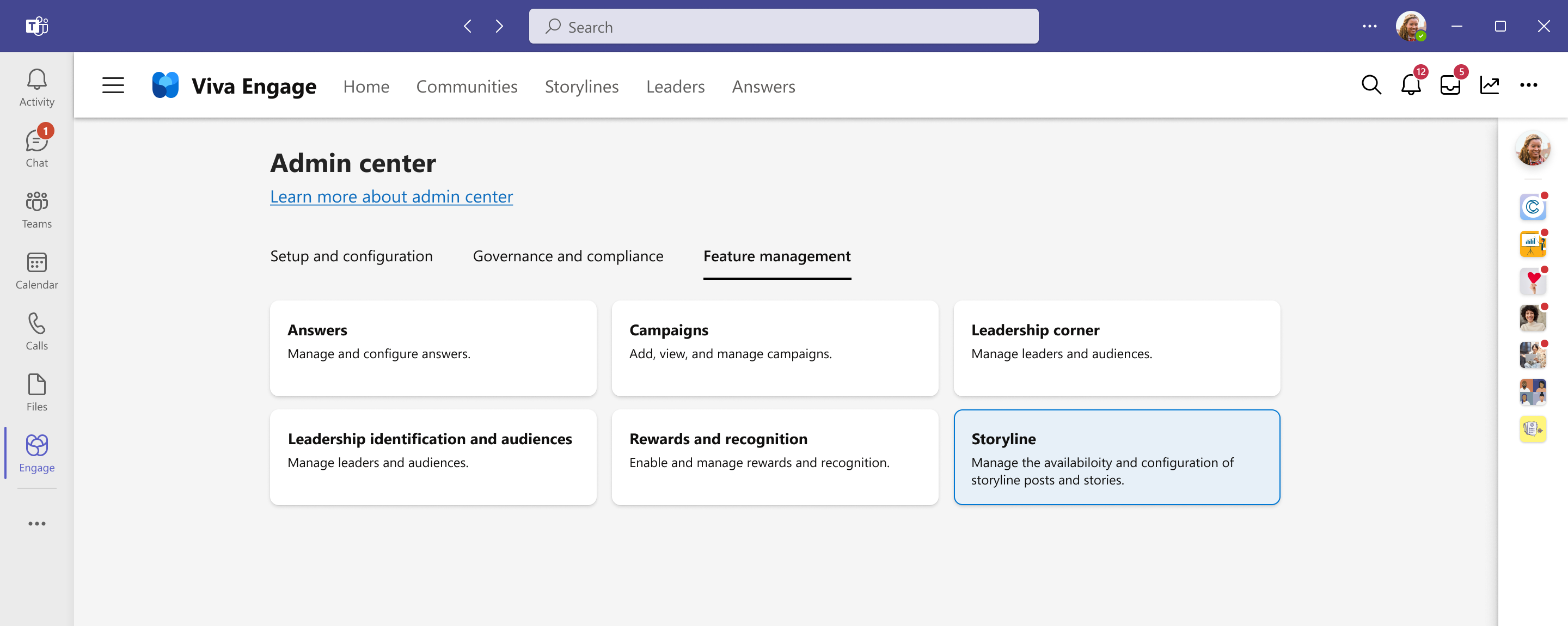Note
Access to this page requires authorization. You can try signing in or changing directories.
Access to this page requires authorization. You can try changing directories.
Storyline empowers everyone in your organization to connect and contribute through the Web and mobile applications you use every day—-Outlook, Microsoft Teams, and Microsoft Viva. Through storyline, leaders can reach and engage their teams. Employees at all levels can share updates and experiences with followers and colleagues across the organization.
When you enable storylines in your organization, the following changes appear in the Viva Engage app:
- Internal (nonguest) users who have access to Viva Engage see a new default Storyline tab on their user profile page.
- Users see a new Storylines page. Users can toggle between a personalized feed of posted content or a focused feed that includes only storyline content from people that the user follows.
Set up storyline
Engage administrators manage storyline for their organizations in the Engage admin center. When an admin enables Storyline in Viva Engage for their tenant, all users also see the storyline in Microsoft Teams.

To access storyline settings, select the Settings gear, and select Admin Center.
On the Feature management tab, select Storyline to customize settings.

The Viva Engage admin center's Manage storyline page controls the availability of storyline in the organization.
After you enable storyline, all network members with access to Viva Engage see the Storyline tab, and a storyline feed on their profile page. They can also react and respond to others’ storyline posts.
Note
After you enable storyline, network users also see the Storyline feature in Microsoft Teams. Users don't need to install anything else to see the storyline.
To restrict storyline usage, see Limit which users can post to their storyline.
Note
Guests don't have their own storyline and can't see storyline content from internal users.
Advanced settings
Admins use advanced settings to control storyline configuration for their organization. These settings establish the default behavior for storyline notifications and restrict who can post to storyline.
Set default notification channels for storyline posts
By default, storyline notifies users in Viva Engage, Teams, the Teams storyline, and by email when people they follow post to their storyline page. Notifications depend on the experiences that the user activates. Network and verified admins can change defaults to control which notifications appear after a user follows someone.
Users can also change the default notification setting for each person they follow. Doing so filters the notifications they receive from them, but don't affect what the other user does.
System default selections for notifications include:
- Microsoft Teams notifications, which appear in the Teams Activity feed.
- Email notifications. Email supports actionable messages, which lets users view and reply from Outlook Web Access.
- Viva Engage notifications, which appear as Viva Engage notification bells.
Limit which users can post to their storyline
By default, all internal Viva Engage users can post to their own storyline feed. Admins can override the default and limit this option to specific users. This setting controls who has a storyline feed on their user profile and who can create new storyline posts. It doesn’t restrict who can view, react, or reply to storyline posts made by others.
To restrict who can post to storyline, from the Engage admin center, go to Feature management > Storyline.
Select Edit in Advanced Settings.
Switch Specify storyline creators to Eligible users from selected group.
Search for and select the group that includes users who should receive their own storyline page.
The supported group types include security groups, mail-enabled security groups, distribution lists, and Microsoft 365 groups. When a group is selected, Viva Engage checks the group membership on a daily basis to assign storyline privileges.
Your changes should take effect within minutes. Backend membership changes in the selected group can take up to 24 hours to apply to storyline privileges.
To delete previous storyline conversations after you disable storyline, use the same processes that you use to delete other conversations in Viva Engage.
What users experience when storyline is disabled
When you disable storyline for a user, the user can't create new storyline posts and the Storyline tab no longer appears on their user profile.
If you disable storyline for all users in your network, storyline doesn't appear in the left navigation pane of Viva Engage for the web, and it doesn't appear in the top navigation of the Viva Engage app for Teams and Outlook.
Even though the user doesn't have a Storyline tab on their profile, their previous conversations remain visible through the All activity feed and through search.
All Storyline content is available through network data export. Networks in Native Mode can also access this content through eDiscovery.
Note
If you need to address objectionable content or security concerns, an effective solution is to delete the conversation or block the offending user.
Configure a multitenant organization to use storyline
When Viva Engage is configured for a multitenant organization, the Multi-tenant Organizations (MTO) setting appears in the Advanced settings of designated hub tenants. This setting enables users on all spoke tenants to engage with storyline posts from the hub tenant. These users can only participate if the multitenant organization configuration in Microsoft Entra ID grants them access to storyline. Learn more about configuring a multitenant organization in Viva Engage.
Security and compliance
Storyline is built on the same content and conversation platform as community messages in Viva Engage. Therefore, you can use the same tools for storyline that you use for monitoring and governance.
- Use eDiscovery in the compliance portal for Microsoft Entra networks.
- Access storyline content through network export.
- Files shared through storyline are stored on OneDrive. Shared files are subject to any governance you already have in place.
- Storyline supports the Report a conversation feature that's available for community conversations.
- Microsoft Purview Communications Compliance (E5): Use AI to monitor conversations for bullying, harassment, or topics that are against usage policy.
In addition to the capabilities listed here, storyline features a feed that includes all storyline posts, sorted by the date the storyline conversation was started. To access this feed, go to the storyline landing page. In the feed, select the filter icon in the upper-right corner to switch the filter to All.
Security, compliance, and governance for files uploaded to storyline posts
Compliance for storyline posts is the same as the rest of Viva Engage. If you're in Native Mode, posts are ingested into the substrate and subjected to the same compliance and eDiscovery capabilities as posts in communities--including communications compliance and retention. Files are stored in OneDrive, where they inherit the same security and compliance policies configured for other files in OneDrive.
When user accounts are deleted (for example, when an individual leaves the company), the system follows the Microsoft 365 user deletion process. Learn more about deleting a user account.
File storage for storyline
Files attached to storyline posts are stored in a hidden library in the author’s OneDrive. There's no entry point to this location in the Microsoft 365 user experience, but you can access it through a URL resembling the following example:
https://<tenantname>-my.sharepoint.com/personal/<useridentifier>/VivaEngage/Attachments/Storyline
To determine the precise URL for a user's storyline page, follow these steps:
Open the user's OneDrive in a browser.
Note the URL to the user's OneDrive.
Locate the user identifier, which is the part of the URL immediately that follows my.sharepoint.com/personal/.
Replace everything after the profile identifier and the backslash plus VivaEngage, without a space, case insensitive. The resulting URL resembles this example:
https://<tenantname>-my.sharepoint.com/personal/<useridentifier>/VivaEngagePress Enter. The library appears.
Open the Attachments folder, and then open the storyline folder. The URL to the folder where storyline files are saved resembles this example:
https://<tenantname>-my.sharepoint.com/personal/<user identifier>/VivaEngage/Attachments/Storyline
Note
Attachment files for Storyline for Teams users get stored in the same hidden folder in each user's OneDrive.
Managing files uploaded to storyline posts
You can use the storyline interface to edit documents and rich media that was uploaded to posts. We strongly recommend that you don't add, replace, or delete documents and rich media directly in OneDrive, as those actions risk breaking the front-end experience of posts in your storyline.
To delete files associated with a post from the VivaEngage library:
- Remove the file from the associated post. From any post, the author or an admin can select the ellipsis (...) menu and choose Edit.
- Navigate to the author's VivaEngage library and delete the file.
Frequently asked questions
Why isn’t storyline available in our organization?
Storyline is supported in Viva Engage networks that enforce Microsoft 365 identity. If your network doesn't enforce Microsoft 365 (formerly Office 365) identity, or if you have a Viva Engage Basic network, storyline isn't available to your organization.
Who can see storyline content?
Storyline content is visible to any internal user who has access to Viva Engage. Guests can't see storyline content.
Does storyline work for guests?
Guests are excluded from storyline access. They don't have their own storyline and can't see any storyline content posted by other users.
Can I control who sees storyline content?
You can't prevent any internal user from seeing storyline content if they have access to Viva Engage. Guests can't see any storyline content.
How do I delete custom cover images that were uploaded to a person's storyline?
From the UI, Engage admins with premium Viva licenses can upload or delete cover photos for any user with the premium Viva license and storyline. From the user's profile page, hover over the profile header and select Upload cover photo. Delete or upload a new cover image, as needed.
If the admin or the user isn't premium licensed, or the user no longer has their own storyline, use the API to delete previously uploaded photos.
From the API, Engage admins or verified admins can delete cover images for any user in their network through an API call. The URL uses this syntax:
engage.cloud.microsoft/api/public/v1/user-profiles/user_id/cover-image
For example, to delete the cover images of a user with ID 1234567890, the URL would be:
engage.cloud.microsoft/api/public/v1/user-profiles/1234567890/cover-image
See also
Overview of the Viva Engage admin center